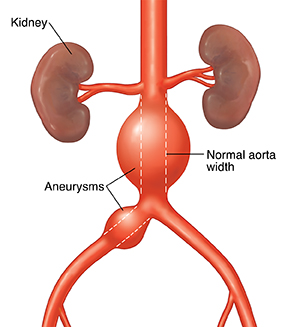Understanding Abdominal Aortic Aneurysm
Understanding Abdominal Aortic Aneurysm
BIG: You may have been told that you have an aneurysm. This is when a weakened part of a blood vessel expands like a balloon. An aneurysm in the main blood vessel in your stomach area is called an abdominal aortic aneurysm (AAA).
What is AAA?

How is an aneurysm found?
AAA usually causes no symptoms. It is often found when tests (such as an X-ray, MRI, or CT scan) are done for an unrelated problem. Or your healthcare provider may find it while feeling your stomach during a routine exam.
Who develops AAA?
These things increase your chances of having AAA:
-
AAA runs in your family
-
Your age—AAA is more likely as you get older
-
Men are more likely than women to have AAA
-
Smoking
-
High blood pressure
-
High cholesterol level (a buildup of fat and other materials in the blood)
-
Injury (such as a car accident
What can be done?
Surgery can be done to remove an aneurysm. Your healthcare provider will weigh the chances that the aneurysm will burst against the risks of treatment. Because a small aneurysm is not likely to burst, it may be watched for a while. When it reaches a certain size, you may have surgery to replace that section of your aorta.
Updated:
March 16, 2019
Sources:
Walker, TG. Clinical Practice Guidelines for Endovascular Abdominal Aortic Aneurysm Aortic Aneurysm Repair. Journal of Vascular Interventional Radiology. 2010; 21(11): s1632-55.
Reviewed By:
Deepak Sudheendra MD